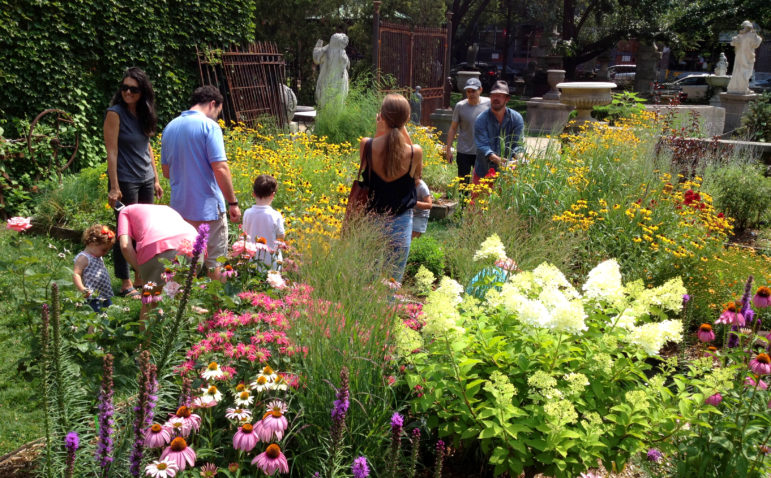
Friends of Elizabeth Street Garden
The Garden
When Haven Green, a senior affordable housing project set to rise on Elizabeth Street Garden in Little Italy was initially revealed in 2017, it was billed as a “win-win solution for the neighborhood.” In order to mitigate the loss of the garden, HPD and city officials including Councilmember Margaret Chin, who originated the land-deal, promised Haven Green would provide both desperately needed senior affordable housing as well as “quality open space.”
With Habitat for Humanity NYC on board as co-developer and spokesperson, the project was supposed to bypass the longstanding debate between housing and open-space advocates. Habitat NYC warned that such a debate would be a “zero-sum game” amid the current housing crisis and the shortage of city-owned land.
But from the onset, developers and city officials appeared to invite opposition when they inflated the size of the open space that would remain and took credit for providing that small area despite the fact that a longstanding zoning regulation required it*.
The lack of transparency from developers and the misrepresentation of both the project and the garden by the city only deepened the divide that existed within the community. As public meetings for the proposal began, the debate quickly deteriorated, and a battle of NIMBY vs. YIMBY played out in local media.
In spite of this fierce debate, both sides were still asking the same question: Why can’t we just have both, housing and garden?
The city’s alleged “win-win solution” at Elizabeth Street hinged on creating a complex that would unify both housing and garden on one site. However, missing from HPD’s request from developers was any real guidelines that would guarantee an equitable “public space.” And even if the green space could, with smart landscaping, overcome the shadows from the imposing seven-story building, architects had failed to incorporate the open space into the design of the building. In terms of balance, what remained of the garden appeared as shadowy leftover space.
The fact that residents and commercial tenants would have direct access and priority usage* rendered HPD’s idea of “dedicated public open space,” inequitable.
The design struggles exposed how unprecedented an undertaking Haven Green actually was. Neither HPD nor developers could provide any example of another housing complex in the city of New York that incorporated privately-owned, publicly-accessible space within the confines of a residential complex. As Community Board 2’s resolution would later reveal, the idea for Haven Green was incomplete: Lead developer Pennrose Properties failed to satisfy the meager requirement HPD had laid out for the open space component of Haven Green.
In order to have both housing and a true public space, Community Board 2 pitched an apolitical plan to build Haven Green on an alternative site that would provide more housing within the same community board.
*All that remained was for Councilmember Chin to initiate negotiations and compromise. That didn’t happen. Instead, a “build affordable housing everywhere possible” slogan emerged for the Councilwoman’s 2017 re-election campaign. Chin had reverse-engineered a city-wide urban planning policy out of a need to justify the destruction of the garden and squash the community-led plan for having the two elements—housing and garden—on separate sites.
Suddenly, the plan for compromise, to have both, meant taking both for housing. But now, in 2019, there’s no evidence that Councilwoman Chin’s “build affordable housing everywhere possible” mantra has been adopted by the city. The only real urban plan that emerges from this crisis-state strategy is that open space should be relegated to exist in the shadow of any new development on city-owned land. Recent news reports reveal that the de Blasio administration is failing to deliver budget allocations for affordable housing and land-deals to build affordable housing on parking lots while pushing ahead with plans for infill developments on playgrounds and open space in NYCHA properties, like Holmes Towers on the Upper East Side.
The insistence by garden advocates to build more housing on the alternative site and preserve the garden in its entirety is based on the reality that housing preference is governed by community board boundaries, not by Council District. Had their community-led plan been put into action when it was initially proposed in 2015, seniors would already be living in new apartments. And the city would have Elizabeth Street Garden as a public park.
But protesting Haven Green wasn’t strictly about preserving the garden. The fact that city-owned land was being privatized for non-permanent affordable housing made the deal seem like a land giveaway. The inclusion of 11,200+ square feet, of below-market, ground floor office space for Habitat NYC’s new headquarters, is simply irreconcilable with either the housing crisis or environmental concerns.
As the Haven Green project heads to a vote at City Council, neither side has ceded any ground, and it’s become clear that developers actually benefited from the housing-versus-gardens debate it warned against because it distracted from the real facts and the hopeless contradictions of the development.
The placement of Haven Green on the functioning garden site actually creates the debate necessary to upend the notion of what constitutes public space, open space, and even office space. As Haven Green purports to be a “model for future development,” this project could redefine what public space is in this city.
Opinion: Elizabeth Street Garden Fans Must Acknowledge the Housing Crisis
For now, the city appears determined to find out just how much green space it can afford to lose. YIMBYs or pro-housing advocates tell us that developments impacting open space and cultural history, whether at Holmes Towers or Brooklyn Botanical Gardens, are just minor encroachments that are commensurate with the housing crisis. But a crisis doesn’t happen all at once, it occurs incrementally, slow enough so that you don’t notice it’s happening, then suddenly all at once.
All too often, the solution to the crisis from pro-housing groups is increased privatization of public space, and that a kick-up to big real-estate from the community is necessary to achieve equality and affordability. Evoking the crisis shields city projects from their failings, alleviates burdens of comprehensive urban planning, and gives cover for politicians to pick and choose winners and losers.
Regardless of the final outcome at City Hall, it’s clear that the Haven Green development won’t settle this debate. The “win-win solution” that HPD has trumpeted at the Elizabeth Street Garden and at Holmes Towers actually prioritizes new housing over preservation.
This strategy will always result in a loser, unless a “do no harm” policy is enacted to preserve existing affordable housing stock as well as the environment, not just on a project-by-project or lot-by-lot basis, but as a city-wide urban policy so that there is one winner: the city as whole.
Eddie Panta is a painter, writer, and event coordinator based in Lower Manhattan. He is a contributor to the local news blog BoweryBoogie.com
*Editor’s note: The original version of this op-ed incorrectly indicated that Speaker Johnson was receptive to the idea of an alternate location for the HavenGreen project. To date, Johnson remains silent about this plan, but Panta says garden advocates still hope his voice will be heard on the issue as it goes to a full City Council vote.
To clarify, proponents of the project misstated the nature of the space during the early days of the discussion; in more recent presentations, the development partners have accurately reported the breakdown between “open” and “public” space.
A further clarification: the “priority usage” referenced here is the natural access advantages that tenants of the site would have to public spaces located there.









One thought on “Opinion: The False Choice Behind the Elizabeth Garden Housing Scheme”
We live in a time where atrocity has become normalized. We have mass murders in our schools. Opioid addiction is skyrocketing. Suicide is skyrocketing. Even people with good jobs, friends and family are falling into despair in record numbers. The pursuit of money for the sake of money is not making anybody happy. If we are to survive as a species it is imperative that we have a cultural and spiritual awakening. We need to reconnect to community and we need to reconnect to nature.
These two things are what community gardens provide in abundance. It’s a quantifiable scientific fact that people who live in proximity to gardens experience significantly higher degrees of emotional well being. A flower is what can make you happy. Helping a neighbor is what can make you happy. Working for and with community is what gives our lives meaning.
And yet the city continues to promulgate the obvious canard that we must choose between Affordable Housing and Community Gardens.
Let’s put an end to this outrageous lie with the facts.
According to the NYC comptrollers office there are 990 “empty lots” that can be utilized for housing. Elizabeth Street Garden, Mandela Garden and Pleasant Village Community Garden are just 3 of them. All three of these gardens together represent less than half of one percent of the total inventory available. That is half of one percent.
We demand that the city take city land. Land that is the property of We The People and create a plan that increases both open space AND truly affordable housing. That is rental housing that is tied to income. We demand that this administration return to us a sustainable, green future, resilient to the effects of climate change. It is your duty to stop unnecessarily dividing people. It is your duty to our community. It is your duty to save the future for our children who are powerless to act.